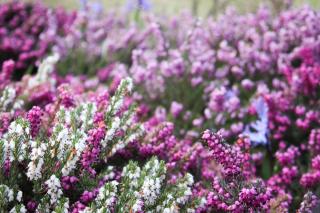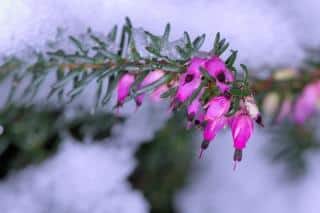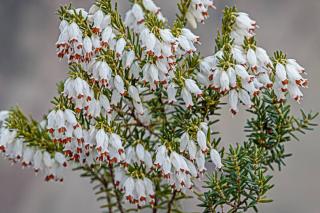

Spreading out to form wonderful carpets of color at the heart of winter, Erica carnea can beat bad weather to the point of sprouting through a blanket of snow. A choreography of white, pink and purple bells swells up from beneath the monotonous white winter mantle. Is this not proof that this small, hardy shrub can take the worst and still, against all odds, thrive?
This plant, a type of heath plant, is native to the higher alpine regions, and can grow in the poorest of soils. Extreme cold and withering heat won’t hurt it in the least. Its slow but regular growth means it’s perfect for use in pots and containers and to decorate garden boxes. Choose the varieties wisely, and you’ll have uninterrupted blooming from November to May.
Erica carnea is one of the most beautiful hardy heathers. With a size that stays within the 6 to 12-inch range (15 to 30 cm), it grows in the wild in the Alps where its pale red blooms coat the fields from January to April.
 An ideal plant to add to low-maintenance gardens, especially if you pair it with ornamental rocks. Toss in a few wispy grasses to introduce a little airiness into the stocky heather-and-rock composition.
An ideal plant to add to low-maintenance gardens, especially if you pair it with ornamental rocks. Toss in a few wispy grasses to introduce a little airiness into the stocky heather-and-rock composition. The only kind of maintenance expected from you is to cut leafy stems back by half after the blooming: this triggers branching out, keeping the plant dense and tight. Not trimming would lead the plant to degenerate and grow sparse and scrawny. Just like lavender, though, a word of caution: don’t cut back too far because heather has trouble creating new shoots from old wood. Always stay within the leafy portion of stems when you cut it back.
The only kind of maintenance expected from you is to cut leafy stems back by half after the blooming: this triggers branching out, keeping the plant dense and tight. Not trimming would lead the plant to degenerate and grow sparse and scrawny. Just like lavender, though, a word of caution: don’t cut back too far because heather has trouble creating new shoots from old wood. Always stay within the leafy portion of stems when you cut it back. In a garden, it helps when Erica carnea is planted in large numbers: a single one won’t be noticed, but a large planted area will look stunning. It’s also possible to set it up between shrubs, so it can weave its way along the ground in a shrub bed that’s planted with small conifers, covering the soil up in a lush, dense blanket, and you can even guide it along edges, lining a walkway for instance.
In a garden, it helps when Erica carnea is planted in large numbers: a single one won’t be noticed, but a large planted area will look stunning. It’s also possible to set it up between shrubs, so it can weave its way along the ground in a shrub bed that’s planted with small conifers, covering the soil up in a lush, dense blanket, and you can even guide it along edges, lining a walkway for instance.
These heather species are excellent companions for taller perennials such as Rudbeckia, Aster and grasses since it helps showcase them against a uniform, dense backdrop.
In garden boxes, Erica carnea is the best friend of silver ragwort, cyclamen, berry shrubs (Gaultheria, Skimmia).
Experiment original landscaping pairings, for instance with ornamental cabbage that boast pink, blue or silver leaves, and even black ones in the case of the edible ‘Nero di Toscana’ kale variety.
 The only weakness this particular winter heather plant has is that whenever it’s not blooming, you feel nothing is happening. This is due to how slow growth is, and to how small the leaves are. However, if you pay careful attention to it, you’ll notice that the hue of its leaves does change when temperatures rise and fall.
The only weakness this particular winter heather plant has is that whenever it’s not blooming, you feel nothing is happening. This is due to how slow growth is, and to how small the leaves are. However, if you pay careful attention to it, you’ll notice that the hue of its leaves does change when temperatures rise and fall.
Read also: Erica heather, the fall and winter heather
Heather plants tend to have a repellent effect on weeds since their roots exude substances that are toxic to young roots. They survive in extremely poor soil thanks to a special fungus that permeates the entire plant. It even hitches a ride along inside the seed to make sure it follows the plant everywhere.